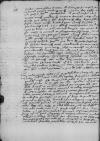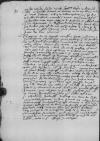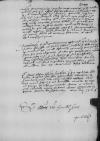⌊⌋ novissimis ex ⌊Hispali⌋, sed Laconice, propter celeriorem postae abitionem 1526-05-13⌊13 Maii1526-05-13⌋ per manus ⌊Welzerorum⌋ ea, quae illo se tempore offerebant. Interea instare apud ⌊maiestatem caesaream⌋ non destiti, quo finis rerum mihi commissarum haberetur, et cum in continuis his laboribus sim versatus sedulo, non potui hactenus quicquam certi ad Maiestatem Vestram Serenissimam perscribere, donec ad praesens tandem hanc absolutionem, quam mitto, extorsi. Qua in re si non feci id, quod debui, certe hoc, quod potui, factum est.
Accepi 1526-06-12⌊12 Iunii praeteriti1526-06-12⌋ ⌊⌋ Maiestatis Vestrae Serenissimae in ⌊Nyepolomicze⌋ 1526-04-05⌊5 Aprilis1526-04-05⌋ datas. A ⌊maiestate regia⌋ per decursum unius anni absque 13 diebus nullas vidi, quo factum est, quod hunc familiarem meum, nobilem ⌊Fabianum Woyanovsky⌋, remittere in ⌊Poloniam⌋ decreverim, a quo omnia, quae hic aguntur et quae hic hucusque egerim viva voce intelligentur, ne quo[d] suspicio fidei meae non conveniens subesse possit, coactusque sum facere, ut illum mitterem ea de re has expensas, quo Maiestas Vestra Serenissima coram liquido intelligeret, quomodo hic vivitur, et quid pro utriusque Maiestatis honore sub persona, quam fero, ⌊hic⌋ cotidie a me expenditur, et quo labore quibusque difficultatibus in hac aula tractantur negotia. ⌊Illius⌋ enim opera fere in omnibus usus sum timuitque hic ulterius apud me perseverare, cum propter aerem, qui illi non omnimode competit, tum etiam propter ⌊inquisitores⌋, a quibus adhuc sibi metuit, ne in illorum manus incidat rursus, cum per quinque menses in illis innocenter pessime sit habitus. Dedi ⌊illi⌋ pro expensis 25 ducatos et equum pro 15 ducatis, proque litteris et expeditionibus, quas secum fert, 10. Summa facit 52(!) ducatos. Ad eum modum hic plurima extraordinarie etiam a me exponuntur, de quibus Maiestati Vestrae Serenissimae aliquando dignam rationem sum redditurus. Ordinarie raro cum tribus ducatis per diem me sustineo, et quolibet mense servitoribus pro salario 7 ducatos expono. Quid pro rebus aliis necessariis, quae cotidianum usum spectant, quid cancellariae scribis iuris consultis et cetera id hominum genus. Nihil tamen in ventum proicio, voluique ut quam minime fieri possit pecuniae Maiestatis Vestrae Serenissimae exponerentur, de quibus nihil aliud revera mihi accedit, quam victus et amictus isque admod[um] tenuis, quo saltem haec persona, quam fero, digne proferri possit. Dati mihi a ⌊maiestate regia⌋ ⌊Cracoviae⌋ in exitu pro servitiis meis 172 floreni, accepi mecum 100 ducatos meos in auro, a domino doctore ⌊Borgio⌋ etiam centum ducatos ⌊hic⌋ accepi in mutuum et <a> ⌊Fuggarorum⌋ factore 150 du[catos], quos nuper per ⌊Georgium Hegel⌋ ⌊Cracoviae⌋ solvere curavi. Nollem quicquam in meum singulare{m} commodum vertere de pecuniis Maiestatis Vestrae Serenissimae, qua de re de meis propriis ad honorem utriusque Maiestatis supellectilem parvam argenteam hic comparavi, qua utique aliis oratoribus non sum inferi[or], quemadmodum latius haec omnia ⌊iste meus familiaris⌋ coram referet. Unde humillime rogo, Maiestas Vestra Serenissima, quod ⌊illum⌋ sub his expensis miserim, boni aequique consulat, cum tanto tempore ab ⌊utriusque Maiestate⌋ nullas litteras acceperim, et cum ha[s] commissiones caesareas tandem ad praesens expediverim, quo commodius perferri possint, non potui mihi temperare, quin ⌊hunc nuntium⌋ mitterem, a quo de omnibus reddetur certi[or].
Scribit mihi Maiestas Vestra Serenissima, quod ⌊Gotefredus Carazolus⌋, qui olim <nomine> ⌊illustrissimae dominae matris⌋ suae agebat ⌊Barzalone⌋, contentaba[t] [se] quolibet mense 60 ducatis. Sciat Maiestas Vestra Serenissima, quod ego certo compertum habeo, nam eo tempore etiam illic agebam, eum habuisse quolibet ducatos 80 et non fuit habitus pro oratore sed pro agente neque etiam umquam in numerum et ordinem oratorum venera[t]. ⌊Is⌋ cum una mula et tribus vel quattuor famulis, quos in dies mutare solebat, se continuit et negotia sibi commiss[a] de industria protraxit, ut ex his 80 ducatis, de quibus vix 20 per mensem consumebat, commodum suum colligeret, neque umquam, nisi per me inductus ad ⌊caesarem⌋ pervenire potuit. Fuit illic longe alia mea et ⌊illius⌋ condicio: ille enim ab ⌊illustrissima olim domina matre⌋ Maiestatis Vestrae Serenissimae quolibet mense 60 ducatos dare solebat, cum ego plus interdum quam centum exponere solebam, fuique igitur non parum ⌊Fuggaris⌋ et ⌊Velzeris⌋ obaeratus. Quae debita aliqua per me soluta ex numero 400 ducatorum, quos ⌊caesar⌋ mihi donaverat, aliquando etiam ⌊maiestas regia⌋ per ⌊Turzonem⌋ in ⌊Augusta Vindelicorum⌋ ⌊Fuccaris⌋ persolvit, sicque se haec res et non aliter habuit. Iste bonus ⌊Gotefredus⌋ pro commodo suo effecit, quod olim illustrissima ⌊domina dux⌋ in illa hereditate ⌊reginae Ioannae⌋, operam et oleum perdidit, cum contenderet cum fisco regio super possessorio relicto petitorio, sciens illustrissimam olim dominam ducem numquam in possessione istiusmodi hereditatis fuisse. Sed de his hactenus.
Quod vero Maiestas Vestra Serenissima mihi providit de centum ducatis quolibet mense, habeo illi, quas exiguitas pectoris mei potest, immortales gratias, velim quod 10 fieri posset. Credat mihi Maiestas Vestra Serenissima, quod hic multae expenduntur pecuniae, licet me in illis expendendis supra morem meum contineam, sed certe hic pro oratore minus exponere non licet neque possum. A ⌊Ioanne Iacobo de Dinguano(!)⌋ hucusque super istiusmodi provisione, neque apud ⌊Fuccaros⌋ aut ⌊Velzeros⌋ ullam commissionem habui, a Velzeris tamen hactenus accepi per litteras cambii ad thesaurarium Maiestatis Vestrae Serenissimae ⌊Nicolaum Antonium Carminianum⌋ id, quod mihi fuit necessarium, hi se mihi praeter commissionem ad fidem meam in dandis pecuniis benevolos exhibuerunt soleoque ab illis in tertium mensem 300 ducatos per modum cambii accipere. Ad praesens vero cum istius ⌊nuntii⌋ expeditione hoc tempus et calculum servare non potero, cum per istos menses 52 ducati extraordinarie pereunt, accedet quod pro futura hieme me iterum munire vestibus cogar rursusque me ad iter versus ⌊Valentiam⌋ accingere, taxam item hospitiorum solvere, quod in ⌊Castilia⌋ non fuit necessarium. Haec igitur in notitiam Maiestatis Vestrae Serenissimae deduco, ut cognoscat, qualiter hic vivitur, quo fides mea, quam Deo bene favente incorruptam sepulchro mecum inferam, Maiestati Vestrae Serenissimae reddatur perspectior.
Hortatur me, quod hic nullum taedium et fastidium donec omnia conficiantur habere debeam, quod facio quam libentissime, modo negotiis Maiestatis Vestrae Serenissimae bene inservire possim. Si tamen hic diutius, quam suspicor, foret immorandum, et nulla alia de re, quam quod de ⌊castro Barensi⌋ finis exspectari debere[t], si his diebus haberi non poterit, satius mihi videretur ac commodius, quod Maiestas Vestra Serenissima aliquem huc sollicitatorem mitteret, qui per mensem 20 aut 30 ducatis se hic sustinere posset. Hunc ego in exitu meo instruerem de omnibus, ne tot impensis Maiestas Vestra Serenissima afficeretur. Trahit me saepe vehemens cupido visendi Serenissimam ⌊Regiam⌋ ac ⌊Reginalem Maiestatem Vestram⌋, ⌊parentes⌋ praeterea et amicos, et ut etiam domi, cum iam 41 annos habeam, rebus et ulteriori vitae meae, quam diu Deus illam concesserit, intendere<m>; vincit tamen incredibilis observantia mea erga Maiestatem Vestram Serenissimam passiones et affectus meos, quae omnia discrimina et difficultates mihi leves facit. Persuadeat sibi igitur de me Maiestas Vestra Serenissima idem, quod de minimis et fidelissimis suis servis solet; non frustrabor Deo duce opinionem.
Superiori die 1526-08-18⌊18 Augusti novissimi1526-08-18⌋ accepi a ⌊Fuccaris⌋ 3 quadragenas sabellinorum, quos Maiestas Vestra Serenissima iam pridem ante unum annum huc miserat, incorruptos et certe optimos. Illos adhuc, donec sim certior, cui dari debeant, apud me continebo. Dominus ⌊comes de Nassaw⌋ se iterum rebus Maiestatis Vestrae Serenissimae bene applicuit et habuit me nuper in prandio, promisitque pro Maiestate Vestra Serenissima omnem operam, et postquam illi ad longum de ⌊vicerege⌋ fuissem conquestus, et quomodo ab eo ⌊status Barensis⌋ appetitus, et omnes nobis difficultates ingestae essent hactenus, videbatur certe condolere et respondit: „Quis est, qui non multa habere velit? Sed desideria non semper succedunt.” innuens viceregem ad statum Barensem inhiasse, at frustra. Pollicebaturque ⌊se⌋ ea de re cum ⌊illo⌋ collocuturum, antequam desuper ⌊caesarem⌋ conveniret. Significavitque mihi paulo ante per dominum ⌊propositum de Waltkirchen⌋, qui hic habet vices cancellarii ⌊imperii⌋, quod cum ⌊vicerege⌋ fuisset locutus. ⌊Qui⌋ ⌊illi⌋ bene in rem Maiestatis Vestrae Serenissimae respondisset, se omnia pro Maiestate Vestra Serenissima facturum, et nisi febricula quadam fuisset praeventus, qua ab hac in quodam castello suo ad 12 leugas diversatur, iam cum ⌊caesare⌋ istius rei se expeditionem habuisse iussitque me bene de ⌊castri⌋ recuperatione sperare. In hoc puncto res adhuc haeret. Decrevi itaque paulo post ⌊viceregem⌋ convenire et arte eum tractare. ⌊Caesar⌋ etiam ante triduum mihi promisit, quod istius rei finem facere velit antequam ⌊vicerex⌋ hinc in ⌊Italiam⌋ secederet illique iniungere, ut res et negotia Maiestatis Vestrae Serenissimae bene et favorabiliter tractaret. Quid hinc futurum, per postam in ⌊Italiam⌋ cum duplicatis expeditionibus, quas per eam viam mittam, Maiestas Vestra Serenissima copiose intelliget.
Quid cum sabellinis Maiestas Vestra Serenissima fieri velit, cum primis mihi significet. Intellexi dominum ⌊comitem de Nassaw⌋ non accipere ab aliquo munera, et si cum his sabellis pati deberem repulsam, satius quod ipsi ⌊caesari⌋ darentur, quo rebus Maiestatis Vestrae Serenissimae propensior afficeretur. Dominus ⌊comes de Nassaw⌋ gravate se implicat alicuius negotiis, quae omnino ut ignem fugere solet. Dominus ⌊magnus cancellarius⌋ constanter adhuc rebus Maiestatis Vestrae Serenissimae addictus est. De hoc solo bono et integerrimo ⌊sene⌋ bene sperare nunc possumus et poterimus semper. Proinde efficiat Maiestas Vestra Serenissima, ut hic mille ducatos habeam, quos bene promeruit. Ego daturus sum operam, ut eos accipiat, licet hoc ab ⌊eo⌋ difficulter impetrabitur, et sic Maiestas Vestra Serenissima hac in aula semper est certum habitura amicum.
Commissiones et litterae, quas ad praesens a ⌊maiestate caesarea⌋ expedivi, sic habent, ut ex ⌊⌋ videbitur, quarum exempla mitto praesentibus, et cum illa iste meus ⌊nuntius⌋ sollicitaverit, de omnibus Maiestatem Vestram Serenissimam coram abunde edocebit.
Imprimis mitto litteras observatorias omnium privilegiorum et litterarum, quas umquam Maiestas Vestra Serenissima ex hac curia habuit, praesertim quae spectant cognitionem secundarum et tertiarum causarum criminalium, sub poena mille unciarum auri, ut omnia ad unguem observentur. Item alias, quibus mandatur, ut de feudo ⌊Montis Serici⌋ iustitia ministre[tur], alias etiam, quibus committitur, quod quicquid stante sequestr[o] ultra solitas et necessarias expensas per officiales caesareos de ⌊statu Barensi⌋ exactum fuerat, Maiestati Vestrae Serenissimae restituatur. Alias praeterea, quod cognitio et punitio delictorum stante sequestro commissorum iuxta formam privilegiorum super ⌊statu Barensi⌋ Maiestati Vestrae Serenissimae remittatur. Istae commissiones ad instructionem magnifici domini ⌊Ludovici Aliphii⌋ per me sunt expeditae, quemadmodum latius ex illis cognoscetur.
De ⌊castro Barensi⌋ hucusque aliud impetrare non potui, quam quod decretum desuper factum in sublatione sequestri observaretur, sic quod liceat Maiestati Vestrae Serenissimae deputare castellanum, donec aliter cognitum fuerit; litteras tamen ad ⌊castellanum⌋ qui nunc pr<ae>est, ut castro cederet, habere non potui, quod adhuc in solo ⌊vicerege⌋ dependet. Quocirca, ut scripsi, daturus sum et apud ⌊illum⌋ atque ⌊caesarem⌋ omnem operam, ut semel exitum istius tragoediae habere possimus. Videor tamen mihi non parum effecisse et hoc studio et cura magnifici domini ⌊magni cancellarii⌋, quod decretum hoc est iterum confirmatum, cum prius non fuerit observatum. Quicquid erit, si ad praesens ⌊castrum⌋ non relaxabitur, exspectandum erit donec terminus impetitoribus status praefigendus transibit, vel eo stante de iustitia decernatur. Impetravi igitur, sicut mihi Maiestas Vestra Serenissima mandavit, beneficio imprimis magni domini ⌊cancellarii⌋ et legis diffamari ⌊⌋ huiusmodi termini praefixionem sub poena perpetui silentii, ne sic negotia Maiestatis Vestrae Serenissimae in perpetuo turbine versentur, et spero Maiestatem Vestram Serenissimam brevi in his rebus finem et securitatem habituram.
Quae spectent asportationem doctoris ⌊Antonelli⌋, non habent hic eum respectum, ut forsan Maiestas Vestra Serenissima suspicatur, neque ideo gravius quicquam hic de Maiestate Vestra Serenissima dicitur seu sentitur, unde eam rem tam acerbissime in animum admittere non deberet, cum hic rebus Maiestatis Vestrae Serenissimae nihil noceat, vix de illa scitur et nihili aestimatur. Quod vero a ⌊consilio collaterali⌋ hanc ob causam ⌊Barium⌋ sit missum, putatur hoc a domino ⌊Sigismundo Loffredo⌋ per neminem quam per dominum ⌊Ludovicum Monte Alto⌋ et illius nebulonem ⌊Hannibalem Baronum⌋ factum. Quapropter dominus ⌊Sigismundus Loffredus⌋ mihi consuluit, ut contra ⌊hos duos⌋ quasi suspectos exceptionem coram ⌊maiestate caesarea⌋ facerem, ne se amplius in negotia ⌊status Barensis⌋ ingererent, quod eo modo feci, ut in commissione desuper videbitur, qua si Maiestas Vestra Serenissima uti voluerit, in illius est arbitrio. Mihi fuit non inconveniens, ut huiusmodi commissionem Maiestati Vestrae Serenissimae transmitterem. Condoleo certo plurimum, quod dominus ⌊Ludovicus Aliphius⌋ <in> indignationem Maiestatis Vestrae Serenissimae inciderit propter ⌊hominem⌋, qui dudum
mortem promeruerit, quae hic neque negotiis, neque existimationi Maiestatis Vestrae Serenissimae officere potest, praesertim cum sciam hoc ex re et commodo Maiestatis Vestrae Serenissimae factum. Proinde supplico Maiestati Vestrae Serenissimae, si quid apud illam preces meae possunt, ut ⌊eum⌋ ab hanc causam gratia sua prosequi non desinat, neque mihi imputet, quod tam fideliter et ex corde pro collega meo et bono amico apud Maiestatem Vestram Serenissimam intercedo, quem alias negotiis Maiestatis Vestrae Serenissimae strenue inservivisse cognovi. Homines sumus, cf. Hier. Ep. 57 12 et errasse humanum est et confiteri errorem prudentis ⌊si erramus, humanum est, veniam tamen, cum erratum fatemur, et apud Deum consequimurcf. Hier. Ep. 57 12 et errasse humanum est et confiteri errorem prudentis ⌋.
Interpretationem 5 articuli matrimonii Maiestatis Vestrae Serenissimae, quae tum mihi fuerat promissa, non potui obtinere. Nihilominus ⌊testamentariis⌋ mandatum est, ne ad testamenti exsecutionem procedant, sicut hoc iam aliquoties ad illos est perscriptum. Optime igitur Maiestas Vestra Serenissima, quod cum legatariis[1] sub protestatione circa resolutionem compositionem facere<m>, commiserit. Hic omnia eiusmodi ad forum et iudicia remittuntur, quemadmodum hoc ex decretatione desuper videbitur.
Essent adhuc plurima scribenda, quae hic aguntur, sed cum tempora haec sint periculosa, continui me. ⌊Is familiaris meus⌋ omnia coram abundius referet. ⌊Quem⌋ una mecum Maiestati Vestrae Serenissimae {me} humillime commendo et rogo cumprimis de omnibus me certiorem faciat ac reditus mei clementem rationem habeat.






